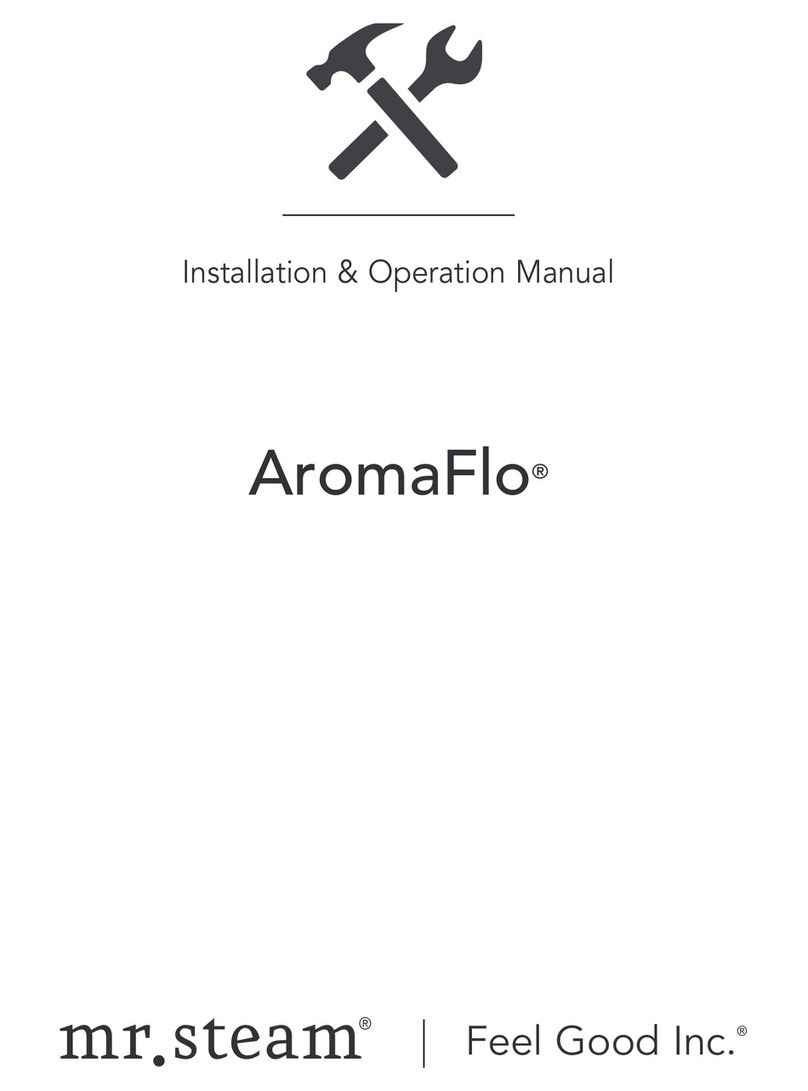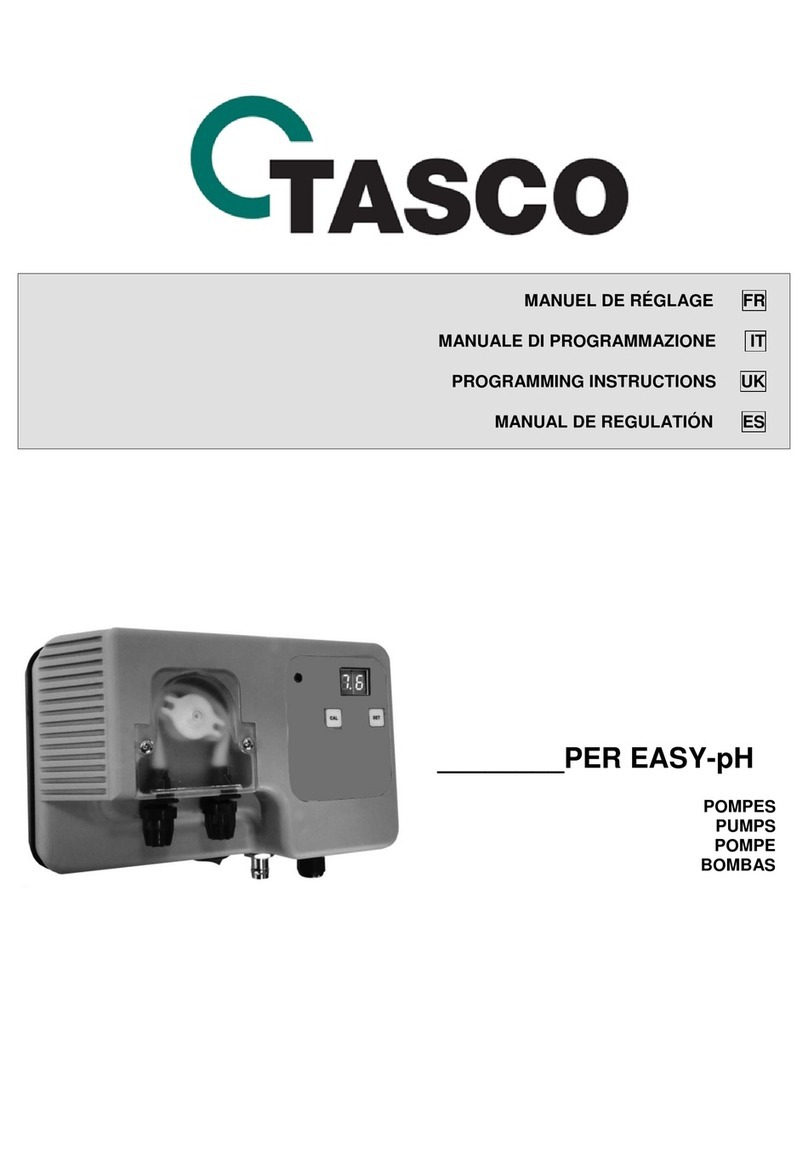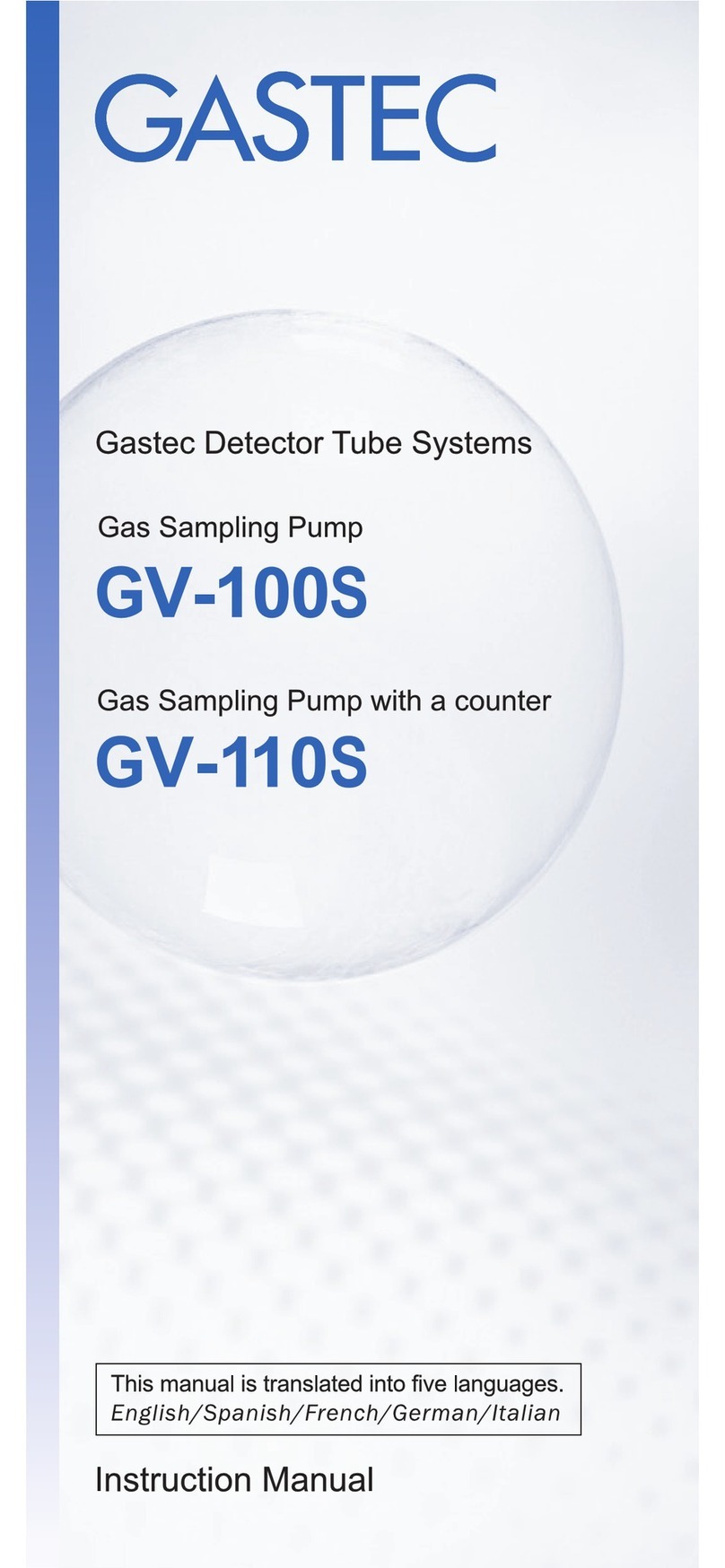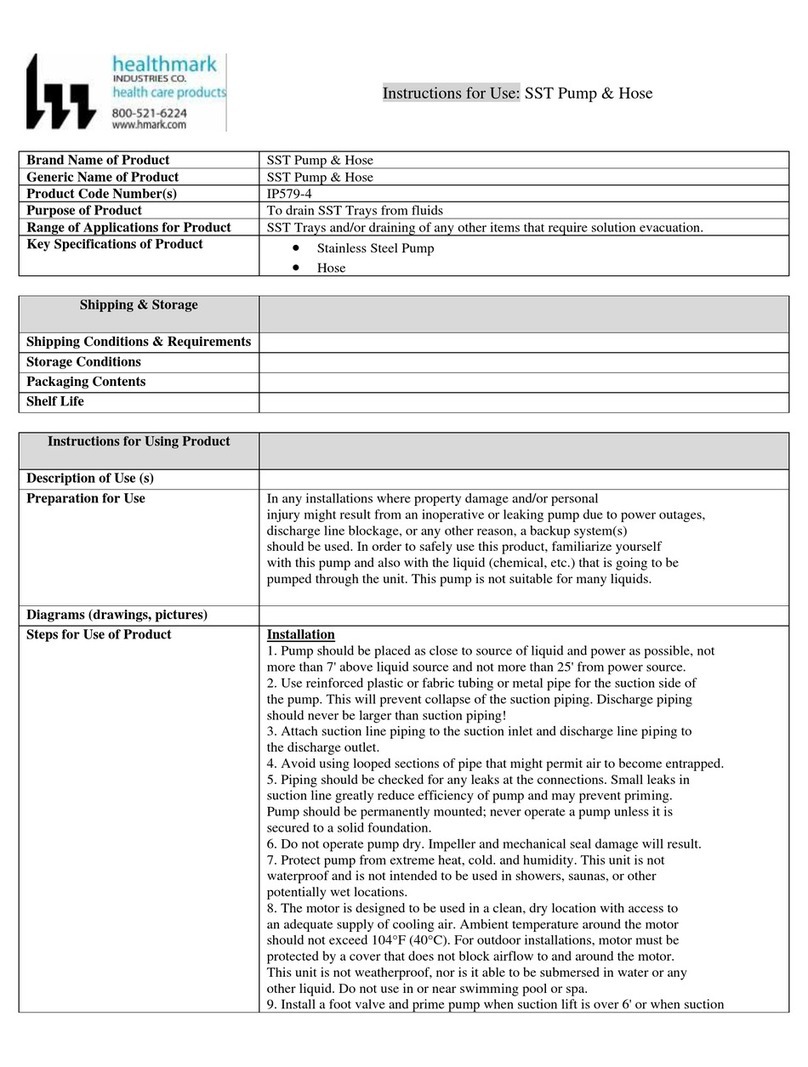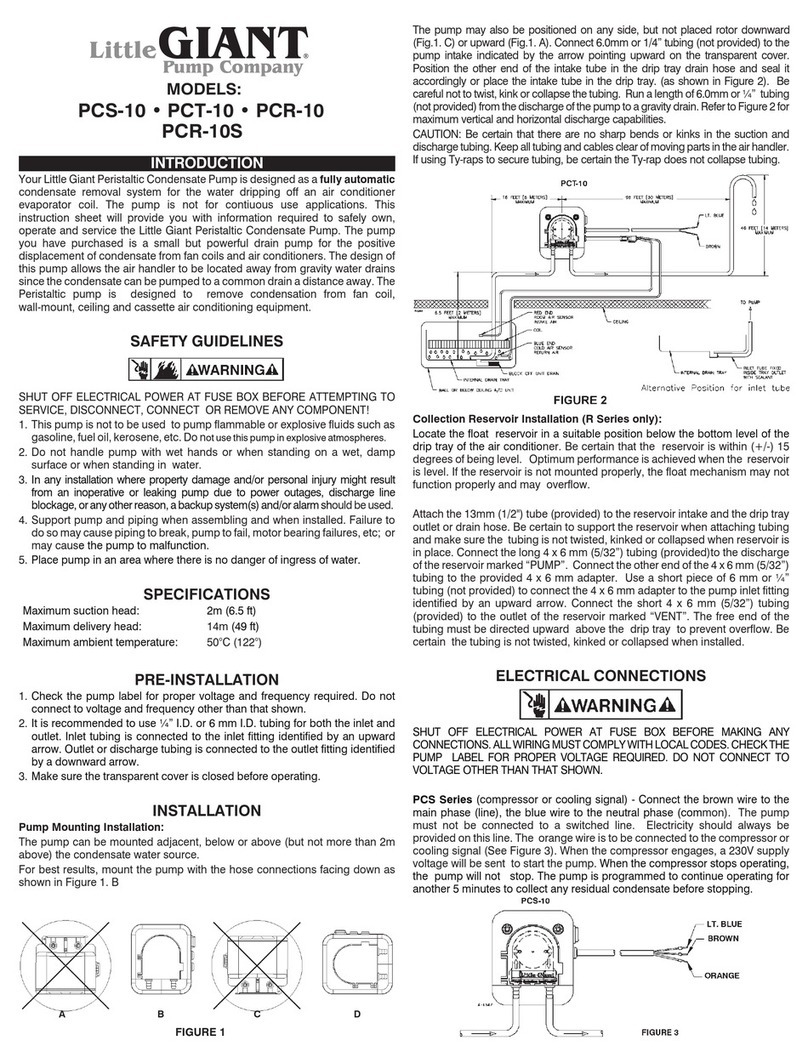FE PETRO STP Installation instructions

STP/ IST Fixed & Variable Length
Installation and Owner’s Manual
©2009 400604005 Rev. 15
Franklin Fueling Systems • 3760 Marsh Rd. • Madison, WI 53718 USA
Tel: +1 608 838 8786 • 800 225 9787 • Fax: +1 608 838 6433 • www.franklinfueling.com

2
Important Safety Messages
FE Petro equipment is designed to be installed in association with volatile hydrocarbon liquids such as gasoline and
diesel fuel. Installing or working on this equipment means working in an environment in which these highly ammable
liquids may be present. Working in such a hazardous environment presents a risk of severe injury or death if these
instructions and standard industry practices are not followed. Read and follow all instructions thoroughly before
installing or working on this, or any other related equipment.
As you read this guide, please be aware of the following symbols and their meanings:
This symbol identies a warning. A warning sign will appear in the text of this document when a potentially
hazardous situation may arise if the instructions that follow are not adhered to closely. A potentially
hazardous situation may involve the possibility of severe bodily harm or even death.
This is a caution symbol. A caution sign will appear in the text of this document when a potentially
hazardous environmental situation may arise if the instructions that follow are not adhered to closely. A
potentially hazardous environmental situation may involve the leakage of fuel from equipment that could
severely harm the environment.
Follow all applicable codes governing the installation and servicing of this product and the
entire system. Always lock out and tag electrical circuit breakers while installing or servicing this
equipment and related equipment. A potentially lethal electrical shock hazard and the possibility of
an explosion or re from a spark can result if the electrical circuit breakers are accidentally turned
on during installation or servicing. Do not smoke while working on or near this equipment, and use
only non-sparking tools.
Before entering a containment sump, check for the presence of hydrocarbon vapors. If these
vapors are inhaled they could cause dizziness or unconsciousness, and, if ignited, hydrocarbon
vapors could explode causing serious injury or death. Electronic and electrical petroleum
monitoring equipment is often housed in containment sumps designed to trap hazardous liquid
spills and prevent contamination of the environment, and, as a consequence, containment sumps
can trap dangerous amounts of hydrocarbon vapors. If these vapor levels reach unsafe amounts,
ventilate the sump with fresh air. While working in the sump, periodically check the atmosphere
in the sump, if vapors reach unsafe levels, exit the sump and ventilate it before continuing
work. Always have a second person standing by for assistance when working in, or around, a
containment sump.
Follow all federal, state, and local laws governing the installation of this product and its associated
systems. When no other regulations apply, follow NFPA codes 30, 30A, and 70 from the National
Fire Protection Association. Failure to follow these codes could result in severe injury, death,
serious property damage, and / or environmental contamination.
Always secure the work area from moving vehicles. The equipment in this manual is usually
mounted underground, so reduced visibility puts service personnel working on this equipment in
danger from moving vehicles entering the work area. To help eliminate these unsafe conditions,
secure the area by using a service truck to block access to the work environment, or by using any
other reasonable means available to ensure the safety of service personnel.
Do not modify the STP / IST, modifying any feature of the STP / IST can cause environmental and
safety issues. FE Petro’s submerged turbine pumps are subjected to rigorous quality control
testing during assembly. Field alteration of the pumps in any way, including shortening of the
column pipe and conduit, defeats these quality tests, and could result in a fuel leak or dangerous
electrical contact.
Thermal expansion can cause pressure to build up in the product lines. FE Petro’s STP / ISTs have
a built-in relief valve to release this excess line pressure back to the tank. Do not use an additional
check valve unless it has the capability to relieve excess pressure back to the tank, as this could
result in a buildup of abnormal pressure in the lines, causing a pipe or joint in the supply line piping
to burst, and release of fuel into the environment.
Warning
Caution
Warning
Warning
Warning
Warning
Caution
Caution

3
Note: Some underground storage tanks are ballasted
with water during construction. DO NOT use the
submersible pump to remove water from the tank.
The pump is designed for use with petroleum
products only, and pumping other uids will
seriously damage the unit. We do not recommend
immersing the pump in water, but, if this does
happen, immediately ll the tank with motor fuel
after the water is removed from the tank. Severe
corrosion takes place very quickly if the unit has
been submerged in water and is then exposed to
air. If the pump will not operate after gasoline is
put into the tank, remove the extractable portion,
remove the black plastic end cap from the pump
motor assembly (PMA), and turn the Allen screw
clockwise at the end of the PMA. This will break
free the PMA from any corrosion that may be
present. Reinstall the PMA end cap and the
extractable section into the pump housing.
Installer:
This instruction booklet MUST be left with the owner of the
service station at which the equipment is being installed.
Station Owner:
Retain these instructions for future use and provide them
to persons servicing or removing this equipment.
Installation Instructions
The piping and underground storage tank must be installed
using good standard industry practices. There are several
publications that can be used for reference, some of which
are:
Automotive and Marine Service Station Code, NFPA •
30A, Flammable and Combustible Code, NFPA 30, and
National Electrical Code, NFPA 70 (NEC), National Fire
Protection Association, Quincy, Mass.
Recommended Practices for Installation of Underground •
Liquid Storage Systems, The Petroleum Equipment
Institute, PEI / RP100, Latest Edition.
Recommended Practices for Installation of Aboveground •
Storage Systems for Motor Vehicle Fueling, The
Petroleum Equipment Institute, PEI / RP200, Latest
Edition.
Installation of Underground Petroleum Storage Systems, •
American Petroleum Institute, API Recommended
Practice 1615, Latest Edition.
Required Tools
Standard 3 / 4" drive ratchet wrench or breaker bar (no •
sockets required)
Standard at head screwdriver•
Wire cutter and stripper•
5 / 32" Allen wrench for securing set screw in telescoping •
pipe coupling (VL units only)
Pipe wrench (36" minimum) for tightening 4" Riser•
1 / 4" hex driver with socket and ratchet wrench, or 1 / 4" •
Allen wrench for attaching PMA
Measuring tape long enough to reach bottom of the tank •
from 30" to 70" above the tank
Note: All wiring must conform to applicable guidelines in
accordance with all federal, state, and local codes.
Failure to comply with all applicable guidelines
could result in an unsafe installation. Use the
following table for maximum wire length to wire
gauge ratios for submersible wiring:
Wire Size Maximum Run
10 gauge 650 feet
12 gauge 400 feet
14 gauge 250 feet
Preparation
1. Fill out the Warranty Registration Card and return
it to FE Petro.
Note: If your STP / IST does not operate correctly or
there are any questions concerning installation or
service, please contact FE Petro Technical Service
at (800) 225-9787.
2. Disconnect power to the submersible pump at the
electrical supply box (if already installed).
3. Tag and lock out electrical circuit breakers so they
are not turned on accidentally.
If installing xed length pump (non-•
variable) with PMA mounted, go to
“secure to tank” section.
If installing variable length pump•
continue with this section.
If installing xed length pump (non-•
variable) without PMA mounted,
complete “mounting PMA” section,
then go to “secure to tank” section.
Warning

4
Mounting the PMA
4. Lay packaged pump on a at, open surface and
remove the package.
5. Flatten pump packaging and lay the PMA on the
end of the pump in preparation for mounting.
6. The PMA mounting hardware kit (# 152350902)
is attached to the PMA packaging. It contains
a gasket, a tube of grease, and four 5 / 16" cap
screws with lockwashers.
7. Remove the two packaging ends and the
protective sleeve from the PMA.
8. Apply grease provided to the inside wall of the
pump motor electrical connector, and the rubber of
the lead assembly connector.
9. Place the gasket on the end of the PMA, aligning
locating pin and bolt holes (Figure 1).
Figure 1: Aligning Pins
10. Mount PMA onto discharge head by aligning
locating pin on PMA with hole in discharge head,
assuring that the lead assembly in the motor
discharge head is seated in its notched position,
and that the PMA gasket is properly in place.
11. Tighten PMA onto discharge head using four cap
screws and lock washers supplied. A cross bolt-
tightening pattern is recommended for securing
PMA (Figure 2).
Figure 2: Tighten Bolts
The motor discharge head must not be
rotated more than one full rotation in
either direction. Rotation could cause
damage to the electrical connections
in the conduit, creating a risk of lethal
electrical shock or equipment failure.
Note: Before assembling the PMA to the discharge
casting make sure the wire lead is properly set
and aligned in the discharge casting. Improper
alignment could damage the wire lead or motor
pins. Failure to push PMA up snug against the
discharge casting before tightening cap screws, or
failure to use a cross-pattern while tightening the
bolts could break the discharge casting or strip the
threads in the PMA.
Note: IST units without a VS4 sufx and STP units with a
VS2 sufx can only be electrically connected to an
IST-VFC or MagVFC.
STP or IST units with a VS4 sufx can only be
electrically connected to a MagVFC. Unlike FE
Petro’s standard pumps, the following pumps
cannot be interchanged with competitive models:
The variable speed PMA VS2 (which is part of IST •
units without the VS4 sufx or the STP units sufxed
with VS2)
The PMA VS4 (which is part of the IST and STP •
units with the VS4 sufx)
12. Apply a non-hardening, UL classied, gasoline-
resistant pipe sealing compound to the riser pipe
threads, if not already installed.
Failure to use a proper thread sealing
compound could result in a lack of
seal where the riser threads into the
tank opening, making it impossible to
perform a tank-tightness test. This may
also create a potential site for fuel to
leak into the environment and / or the
containment sump.
13. Slide riser over the PMA and tighten into manifold
threads (Figure 3). Maximum riser size is found
by taking the grade to tank mounting thread
measurement and subtracting the manifold height
and clearance (6" clearance recommended).
Figure 3: Attach Riser
Note: Riser material required for pump is 4.5" outside
diameter with a .188" wall. Minimum riser length
supplied by FE Petro is 7".
Warning
Warning

5
Example
Grade to tank mounting threads (bury depth) 48"
Minus manifold height without leak detector
(w / leak detector height = 12.50)
-11"
Minus 6" for top clearance (2" minimum) -6
= Maximum riser size 31"
Length Setting
14. Cut wire tie(s) securing the motor wire at the top of
the pump; lay the wires out above the pump head
so that wires can feed through conduit freely when
setting length (Figure 4).
Figure 4: Cut Wires
Failure to cut wire ties prior to setting
pump length could result in damage to
electrical motor wires, presenting a risk
of lethal electrical shock or equipment
failure.
15. Measure from the bottom of the tank to the top of
tank mounting threads. Subtract the distance for
clearance between the PMA and the bottom of the
tank (6" recommended). This is the length to which
the pump should be extracted, measured from the
bottom of the riser threads to the bottom of the
motor end bell.
Note: 6" clearance provides a 5" clearance from the
pump motor end bell to the bottom of the tank once
the riser is screwed into tank mounting threads.
Tank + thread measurement 96"
Distance from bottom (5") + riser thread
engagement (1")
-6"
= Length (bottom of riser to end bell) 90"
Figure 5: Measure Tank
16. Hold the manifold securely to the surface to
prevent damage while setting length.
To allow movement of the telescoping pipe,
verify that none of the pipe coupling setscrews
are in contact with the pipe. Lay a tape measure
out to accurately measure the distance from the
bottom of the riser to the bottom of the pump
motor end bell.
17.
Grasp the pump just above the PMA and pull rmly,
extending to the length required (from Step 15).
Note: Use care to ensure electrical conduit wires
at the top of the discharge manifold are not
damaged during length setting. If column pipe
is extended beyond desired length have a
second person retract conduit wires as column
pipe is shortened. This will prevent damage to
conduit wires.
Figure 6: Measure Riser
The motor discharge head must not be
rotated more than one full rotation in
either direction. Rotating could cause
damage to the electrical motor wires,
presenting a risk of potentially lethal
electrical shock or equipment failure.
Note: O-ring seals inside the locking coupling may have
sealed to the column pipe during shipping. Spin the
motor discharge head slightly (not more than one
full rotation) while pulling to loosen the O-ring seals.
Warning
Warning

6
18. Once the length is correct, lock the STP length by
tightening all three coupling setscrews. Tighten the
setscrews nger-tight, making sure they come into
contact with the pipe (Figure 7).
19. Tighten each setscrew an additional full turn
minimum. The head of the setscrews should be
ush or below ush with the outer surface of the
coupling (Figure 8).
Setscrews
3 places
Figure 7: Install Setscrews
5 / 32"
Allen
Wrench
Figure 8: Tighten Setscrews
Failure to properly tighten the coupling
setscrews at this stage could present
a risk of death, serious bodily injury
and / or equipment damage due to
movement of pipes during installation.
PMA Wiring
20. Measure approximately 6" of wire from the
discharge manifold; cut off excess wire and
discard (Figure 9).
Figure 9: Measure and Cut Wire
21. Place the three wires through the contractors plug
assembly (from hardware pack p / n 400301903)
as shown in gure 10.
Figure 10: Wire Through Contractor’s Plug
22. Using the screwdriver slide the contractors plug
into its seat in the discharge manifold. Tighten the
two screws in the contractor plug to secure it in
place (Figure 11).
Figure 11: Attach Contractor’s Plug
23. Strip the wire insulation back approximately 3 / 8"
on the three motor leads. Using the wire nuts
supplied (from hardware pack p / n 400301903)
connect to the wires from the electrical connector
orange to orange, black to black, and red to red.
24.
Coil the wires and push into the discharge manifold
cavity using care to ensure wires are not damaged
on discharge manifold threads (Figure 12)
.
Figure 12: Push Wires into Cavity
Damage to the electrical conduit wires
creates a risk of lethal electrical shock
and equipment failure. Do NOT use
equipment if electrical wires have
been damaged (contact FE Petro for
assistance).
25. Tighten the discharge head cover (from hardware
pack p / n 400301907) in place using a 3 / 4" ratchet
or breaker bar (Figure 13).
Warning
Warning

7
Figure 13: Tighten Discharge Head Cover
Secure to Tank
Note: The bottom end-bell of the PMA is not designed
to support the weight of the entire pump. Resting
or dropping the pump on this end-bell may
damage the plastic end-bell and the plastic pump
components inside. This type of damage is not
considered a manufacturing defect under FE
Petro’s warranty.
26. Measure the pump, from the bottom of the
threaded riser to the bottom of the pump-motor,
and compare this to the tank measurement,
measured from the mounting ange to the inside
of tank bottom. The STP / IST and riser are sized to
place the intake (at the bottom of the pump-motor)
approximately 5 inches off the bottom of the tank.
If the difference between the bottom of the pump
motor and the bottom of the tank is more than
6 inches or less than 4 inches, verify that this is
the correct pump for this tank installation. If it is
not the correct pump and is outside the above
specications, contact FE Petro, Inc. sales
representative or the FE Petro, Inc. factory.
27. Apply a non-hardening, UL classied, gasoline-
resistant pipe sealing compound to the riser pipe
threads.
Failure to use a proper thread sealing
compound could result in a lack of seal
where the riser threads into the tank
opening, making it impossible to perform
a tank-tightness test. This may also
create a potential site for fuel to leak into
the environment and / or the containment
sump.
28. Carefully lower the unit into the tank, and engage
the threaded riser of the pump into the threaded
ange on the tank. Tighten the riser into the tank
using a large pipe wrench until a water / air tight
joint has been made. Do this by turning in the
tightening (clock-wise) direction only.
Turning the pump in the loosening
direction during the tightening process
may scrape away the thread sealing
compound, making it impossible to
perform a tank-tightness test. This may
also create a potential site for fuel to
leak into the environment and / or the
containment sump.
29. Connect the supply line piping to the discharge
port in the discharge manifold assembly. The
discharge port is the 2-inch NPT vertical opening.
30. Connect the electrical conduit with approved
ttings per NFPA 30, NFPA 30A, and NFPA 70 to
the junction box (see Figure 15).
31. Remove the junction box cover (see Figure 15),
and remove the compression seal (contractors
plug) by loosening the screw(s) (do not remove
screw). A four hole compression seal (contractors
plug) is provided on all units,
On single phase units, two power wires, one •
ground wire and a blank (with celcon rod
supplied to ll forth hole).
For three phase units, three power wires and •
one ground wire.
32. Verify that the power is still OFF at the supply box.
33. Pull wires from power supply into the junction
box and feed through the compression seal
(contractors plug).
34. Replace the compression seal and tighten
into place securely. All wiring must be done in
accordance with the National Electrical Code
(NEC) and any other local, state, or federal
regulations required.
The compression seal (contractors
plug) is not intended to replace the
vapor explosion seals required by
the NEC. All materials used between
the power supply box and the pump
junction box must be gasoline and oil
resistant. Failure to comply with these,
and all applicable NEC guidelines,
could result in an unsafe installation.
35A. SINGLE PHASE UNITS: Connect the ground wire
to the lug in the junction box; using the wire nuts
supplied (from hardware pack p / n 400301901)
connect the wires from the power supply to the
orange and black wires in the junction box. A
capacitor is required and color-coding is not
necessary.
Warning
Caution
Warning

8
35B. THREE PHASE UNITS (except IST or STP units
with VS2 or VS4 sufx): Connect the ground wire
to the lug in the junction box. Connect any three
wires from the pump to any three wires from the
three-phase power source using the wire nuts
supplied (from hardware pack p / n 400301902).
Capacitors are not needed for three phase units.
Install a pressure gauge in the line test port
(see Figure 15), turn on the pump, and read the
pressure gauge. Turn off the pump at the power
supply, and change the connection of any two
wires at the pump. Turn the pump back on and
read the pressure gauge again. The electrical
connection that gives the higher reading on the
pressure gauge is the correct one.
35C. IST UNITS or STP units with a VS2 or VS4 sufx:
Connect the ground wire coming from indoors to
the ground lug in the junction box. Connect any
three wires from the pump connector assembly to
the three power wires coming from the Variable
Frequency Controller (VFC). Capacitors are
not needed for these units. Detailed installation
instructions for the VFC should be referenced
when connecting the VFC. These are supplied
with the VFC.
Not installing a ground wire increases
the risk of lethal electric shock and
equipment failure. All holes of the
compression seal (contractors plug)
must be lled with wires or a celcon rod
to enable it to seal.
36. Replace the junction box cover and tighten
securely.
The pump discharge manifold has
two labeled ports: one for the syphon
system and one for the tank. A piston
leak detector must be vented to the tank
port (lower port) only. Do not connect a
piston leak detector to the syphon port
because this will make the leak detector
inoperative, resulting in an increased
risk of contamination of the environment
(see tank port in Figure 14).
37. Connect power to the submersible pump at the
electrical supply box.
38. Test proper operation by dispensing product into
calibration can.
39. Turn off the dispenser switch. Feel the
submersible pump to make sure that the pump has
stopped running.
Note: If the pump does not turn off when the dispenser
switch is turned off, this may indicate an electrical
problem in the dispenser or other wiring error or
malfunction. Call this to the immediate attention of
a qualied electrician.
40. Visually check for leaks on the manifold head
during pump operation and after.
41. Install a pressure gauge in the line test port to
ensure that the STP / IST is providing proper line
pressure.
42. Turn on the STP / IST. While running, the pressure
should be above 24 psi (1.65 bar). PMA size will
affect psi.
43. Turn off the STP / IST and verify that the line
pressure is holding.
44. Remove the pressure gauge and replace the plug.
45. Turn on the STP / IST and, again, visually check for
any leaks.
Warning
Caution

9
Approximate STP / IST Specications
Operating
Pressure (PSI)
PMA
Length (in)
S.F.
Amps
Locked
Rotor Amps
Winding Resistance
Model Description R-B R-O B-O
STP33*208 / 230 V, 60 Hz, 1 ph 27 16 3.1 11 27 19 8
STP75*208 / 230 V, 60 Hz, 1 ph 30 18.25 6.1 27 20 17 3
STP150*208 / 230 V, 60 Hz, 1 ph 32 21 10.5 39 15 13 2
STPH150*208 / 230 V, 60 Hz, 1 ph 45 21.75 10.5 39 15 13 2
STP200+208 / 230 V, 60 Hz, 1 ph 36 23.75 11.4 41 4.6 3 1.8
STPH200+208 / 230 V, 60 Hz, 1 ph 46 24.5 11.4 41 4.6 3 1.8
STP75B++ 200 / 250 V, 50 Hz, 1 ph 37 20.5 5.6 23 27 23 4
STP150B++ 200 / 250 V, 50 Hz, 1 ph 38 22.75 10.2 28 16 13 3
STPH150B++ 200 / 250 V, 50 Hz, 1 ph 48 23.25 10.2 28 16 13 3
STP200B‡200 / 250 V, 50 Hz, 1 ph 37 25.75 10.9 36.5 5.5 3.5 2
STPH200B‡200 / 250 V, 50 Hz, 1 ph 44 26.25 10.9 36.5 5.5 3.5 2
STP75C 380-415 V, 50 Hz, 3 ph** 37 19.75 2.1 10 29 29 29
STP150C 380-415 V, 50 Hz, 3 ph** 38 21.75 3.4 14 14 14 14
STPH150C 380-415 V, 50 Hz, 3 ph** 48 22 3.4 14 14 14 14
STP200C 380-415 V, 50 Hz, 3 ph** 37 23.5 4.1 22.5 11.6 11.6 11.6
STPH200C 380-415 V, 50 Hz, 3 ph** 44 24 4.1 22.5 11.6 11.6 11.6
IST / STPVS2^190 V, 70 Hz, 3 ph†24-42 20 6.7 N / A 2.5 2.5 2.5
ISTVS4 / STPVS4^^ 190 V, 70 Hz, 3 ph†24-42 25 14.4 N / A 1.2 1.2 1.2
Symbol Key
* Use a 15 µF, 370 V, single phase, 60 Hz capacitor
+ Use a 40 µF, 370 V, single phase, 60 Hz capacitor
++ Use a 15 µF, 440 V, single phase, 50 Hz capacitor
‡ Use a 40 µF, 440 V, single phase, 50 Hz capacitor
† 190 V, 70 Hz, 3 ph power to variable speed units is output from IST-VFC or MagVFC only (VFC’s are powered
by 200-250 V, 50 or 60 Hz, single or 3 phase input)
^ Use with IST-VFC or MagVFC controller only, No Capacitor
^^ Use with MagVFC controller only, No Capacitor (3 phase input is required for full VS4 output))
** No capacitor is used with 3 phase pump motor assemblies
Note: The models listed in the table above may contain (ANZ) for ANZEX certied pumps, or (ATX) for ATEX certied
pumps.
Warning FE Petro’s STPs are designed for use with motor fuels, and they are UL listed for blend
concentrations of:
Standard Models AG (Alcohol / Gasoline) Models
0% - 15% ethanol or methanol and gasoline 0% - 85% ethanol or methanol and gasoline
20% MTBE with 80% gasoline 20% MTBE with 80% gasoline
20% ETBE with 80% gasoline 20% ETBE with 80% gasoline
17% TAME with 83% gasoline 17% TAME with 83% gasoline
Diesel, fuel oil, avgas, jet fuel, or kerosene may also be used with our PMAs. The maximum liquid
viscosity for a product is 70 S.S.U. at 60° F.
Using our PMA in liquids other than those mentioned above has not been tested. The reaction of
other liquids with seals and wetted surfaces of the pump is unknown. A hazardous situation may
result from using other liquids with our pump.

10
Manual Pressure Relief
The manual line pressure relief (see Figure 14) is located
in the center of the stationary manifold under a brass
cap. It is available on all pumps manufactured after April
of 1996. FE Petro makes it easy to relieve the pressure
in the piping system anytime routine maintenance or
troubleshooting must be performed.
Simply remove the brass cap at the top of the stationary
manifold, and turn the pressure relief screw counter-
clockwise until you come to the screw’s retaining ring
(approximately 4 complete turns). This allows the pressure
in the piping system to bleed back to the storage tank.
Next, turn the screw clockwise to its original position
to close the path (turn snug, do not over tighten); then
replace the brass cap. Line side pressure is now relieved
and maintenance or troubleshooting can be performed
without having to contain excess product that escapes
when the system is pressurized.
Clamp Valve (Check Valve Clamp)
The clamp valve (see Figure 14) is located directly
above the check valve inside the stationary manifold of
the submerged pump. It consists of a lead screw with a
sealing disk attached. The head of the screw is accessible
by removing the 1 / 4" line test port pipe plug on the check
valve cover of the STP / IST.
The cavity under the 1 / 4" pipe plug is
at full pump pressure and product will
be released through this opening. If
the pump is equipped with a manual
pressure relief, use it to relieve line
pressure prior to removing the plug.
For normal operation, the clamp valve should be rotated
fully counter-clockwise where a star washer locks it in
place. Be sure to replace the 1 / 4" pipe plug. During a
line test, the clamp valve should be rotated fully clockwise,
where the sealing disk secures against the check valve.
This blocks the pressure relief valve in the check valve so
it does not relieve line pressure back to the tank.
Syphon Systems (Optional)
Syphoned tanks should be of the
same diameter with tank bottoms
located on the same horizontal plane.
Using tanks of different diameter, or
installing the bottoms of the tanks on
different horizontal planes may create
a potential site for fuel to leak into the
environment and / or the containment
sump due to overll of the tank(s).
Some jurisdictions allow two or more tanks of the same
product grade to be manifolded together with a syphon
loop. These systems usually have a single submersible
pump, and the syphoning action keeps the tanks
level while pumping out of only one tank. All FE Petro
submersible pumps have syphoning capability built into
the pump. However, if a syphon check valve is required,
it must be ordered separately. The outlet of the syphon
check valve should be connected with a line to the highest
spot in the syphon loop. At this point the submersible pump
creates a vacuum of 20–28" Hg.
When correctly installed, the syphon action between the
tanks will continue whether the pump is running or not, as
long as the product level in the tanks is higher than the
bottom of the syphon loop vertical piping. The function of
the STP / IST in the syphon system is merely to prime the
syphon line, removing the air and allowing the syphon to
take place.
Note: The syphon port on FE Petro submersible pumps
was designed to be connected to the syphon piping
between tanks. Using the vacuum port (syphon
port) for other purposes may create complications
with the pump’s ability to draw a vacuum because
of excessive foreign materials being drawn into
pump components.
Note: A fuel lter, between the syphon check valve and
the syphon loop, may be useful to help eliminate
debris from entering the syphon check valve.
Debris can keep a syphon check valve from
operating properly. Be sure to use a fuel lter,
which is compatible with the application.
Warning
Warning

11
Wiring Diagram 1

12
Wiring Diagram 2
Note: For further wiring diagrams, see installation and owners manuals that came with pump controller. Wiring must
conform to all federal, state, and local electrical codes. Contact FE Petro Technical Support for further assistance.

13
PMA, Riser & Check Valve For VL & Fixed Length
Item # Part # Description Qty
1 400125001 3 / 16 x 1 5 / 8 Spiral Pin 1
2 400615001 Manual Relief Plug 1
3400211114 O-Ring, Plug 1
4400627001 Retaining Ring 1
5 400616001 Manual Relief Screw 1
6400333012 O-Ring, Relief Screw Top 1
7 400333007 O-Ring, Relief Screw Bottom 1
8 400628901 Manual Relief Plug Assembly
(includes items #2 and #3)
1
9 400629901 Manual Relief Screw Assembly (includes item
#4, #5, #6, and #7)
1
10 400259001 1 / 4 NPT Pipe Plug
(may purchase locally)
3
11 400137937 Syphon Check Valve –
12 400221930 Discharge Manifold 1
13 151213930 Lead Assembly 156" Length 1
151213932 Lead Assembly 240" Length 1
14 Purchase
Locally
Stationary Vapor Tube
3 / 8 OD x .035 Wall
–
15 4001689XX
(xx = length)
Riser 4 1 / 2 OD x .188 Wall Steel Tubing 1
16 Purchase
Locally
1 / 2 Steel Banding –
17 400600002 5 / 16-24 x 7 / 16 Set Screw
for VL units only
3
18 400333015 O-Ring, Motor Discharge 1
19 400264009 5 / 16-18 x 1 1 / 8 Socket Head Cap Screw 4
20 400263004 5 / 16 High-collar Lock Washer
(may purchase locally)
4
21 402449001 Gasket, PMA 1
22 PMAXXX
(XXX
indicates
options & HP)
Pump Motor Assembly
(includes item #35)
1
24 400981001 3 / 8-16 x 1 Hex Head Screw
(may purchase locally)
2
25 400285002 3 / 8 Standard Lockwasher
(may purchase locally)
2
26 400197930 Cover, Manifold Assembly
(includes one each of items #10 & #27, and
two each of items #24 & #25)
1
27 400333238 O-Ring (A / G compatible) 1
29 400147930 Valve, Clamp Assembly
(includes item #28)
1
30 400174930 Spring, Check Valve 1
34 400988931 Check Valve, Standard 1
400988932 Check Valve, Model R 1
400988933 Check Valve, Model W 1
402459931 Check Valve, Model 65 PSI 1
400988934 Check Valve, E85, Standard 1
402459932 Check Valve, E85, Model 65 PSI 1
(each Check Valve includes item #27)
35 152350902 PMA Hardware Pack
(includes item #21 and
four each of items #19 and #20)
–
Figure 14

14
Discharge Manifold Assembly
Item # Part # Description Qty
1400192930 Cover, Junction Box
(includes item #2)
1
2400210233 O-Ring 1
3400655001 Boot, Capacitor 1
4
(does
not
include
item
#3)
400170931 Capacitor Assembly
60Hz, 15 µF, 370V 1Ø
1
400170933 Capacitor Assembly
50Hz, 15 µF, 440V 1Ø
1
400170934 Capacitor Assembly
60 Hz, 40 µF, 370 V 1Ø
1
400170935 Capacitor Assembly
50Hz, 40 µF, 440V 1Ø
1
N / A Not required for 3Ø units
including IST / VS2
–
6400257001 Retaining Ring 1
7 400258002 3 / 8-16 x 1 1 / 4 Hex Head Bolt
(may purchase locally)
4
8 400285002 3 / 8 Standard Lockwasher
(may purchase locally)
4
9400280001 3 / 8 Standard Flat washer
(may purchase locally)
2
10 400651930 Junction Box Assembly
(includes two of each: Item #7, #8, & #9)
1
11 400210212 O-Ring 2
Item # Part # Description Qty
13 400200930 Wire Connector Kit
(includes male / female connectors,
(2) item #11, (1) each item #6, #12, & #20)
1
14 400589930 Cover
(includes item #15)
1
15 400210229 O-Ring 1
16 400236903 Plug, Contractors 2
17 400259002 3 / 8 NPT Pipe Plug
(may purchase locally)
1
18 400562901 Syphon Jet Assembly 1
400562903 Syphon Jet Assembly, E85 1
19 400211046 O-Ring 1
20 400249001 Retaining Ring 1
22 400250002 1 / 8 Dia. x 1 / 2 Roll Pin 1
23 400333343 O-Ring
(A / G compatible)
2
24 400333340 O-Ring
(A / G compatible)
1
25 400259005 2NPT SQ Head Plug 1
1
2
3
4
6
7
8
9
10
16
14
7
8
23
24
25
22
11
11
20
12
13 15
16
17
18
19
Line Test Port
Figure 15

15
Syphon Check Valve
Item # Part # Description Qty
1400137930 Syphon Check Valve 1
Control Box Assembly (STP-CBS)
Figure 16
Figure 17
Item # Part # Description Qty
1400575001 Power Switch
(for CBS and CBBS models)
1
2400574001 Bracket, Power Switch 1
3 400158901 Light Assembly, 120V (CBS) 1
400158902 Light Assembly, 240V (CBBS) 1
4400215931 Relay, 30A, 120V 1
400215933 Relay, 30A, 240V 1
5400278005 Terminal Strip 1
6 402410001 Label, Terminal Strip (CBS) 1
402410002 Label, Terminal Strip (CBBS) 1
7 400817901 Cover & Enclosure 1
8 400819001 Wiring Diagram (CBS) 1
400819002 Wiring Diagram (CBBS) 1
Enclosure dimensions: 8.5"H x 5"W x 3"D (215mm x 127mm x 76mm)

Figure 18
Discharge / Leak Detector
Centerline
Discharge / Leak Detector
Centerline
Line Test port
¼" NPT
Vapor Recovery
Discharge Port 1" NPT Riser / Column Pipe Centerline
Riser / Column Pipe Centerline
11.70"
7.55" R
10.45"
8.12" R
3.00"
5.80"
3.63"
Leak Detector Port
2" NPT
Discharge Outlet
2" NPT
12.50"
Riser Pipe
4" NPT
Tank Port
¼" NPT
Syphon Port
¼" NPT
10.65"
5.80"
©2009 FFS 400604005 Rev. 15
This manual suits for next models
21
Table of contents
Popular Water Pump manuals by other brands
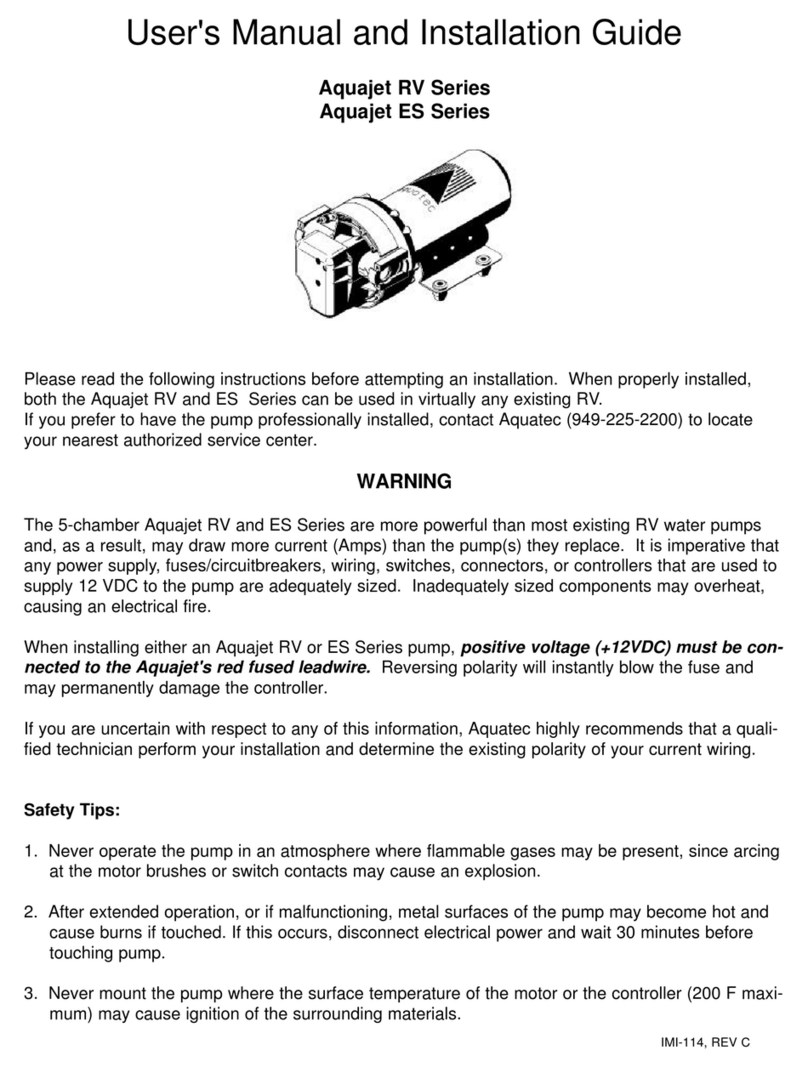
AQUATECH
AQUATECH Aquajet RV Series User manual and installation guide

EUROPRO
EUROPRO MIXPRO 28 Manual instructions

Little Giant
Little Giant 10S-CIA-RFS manual
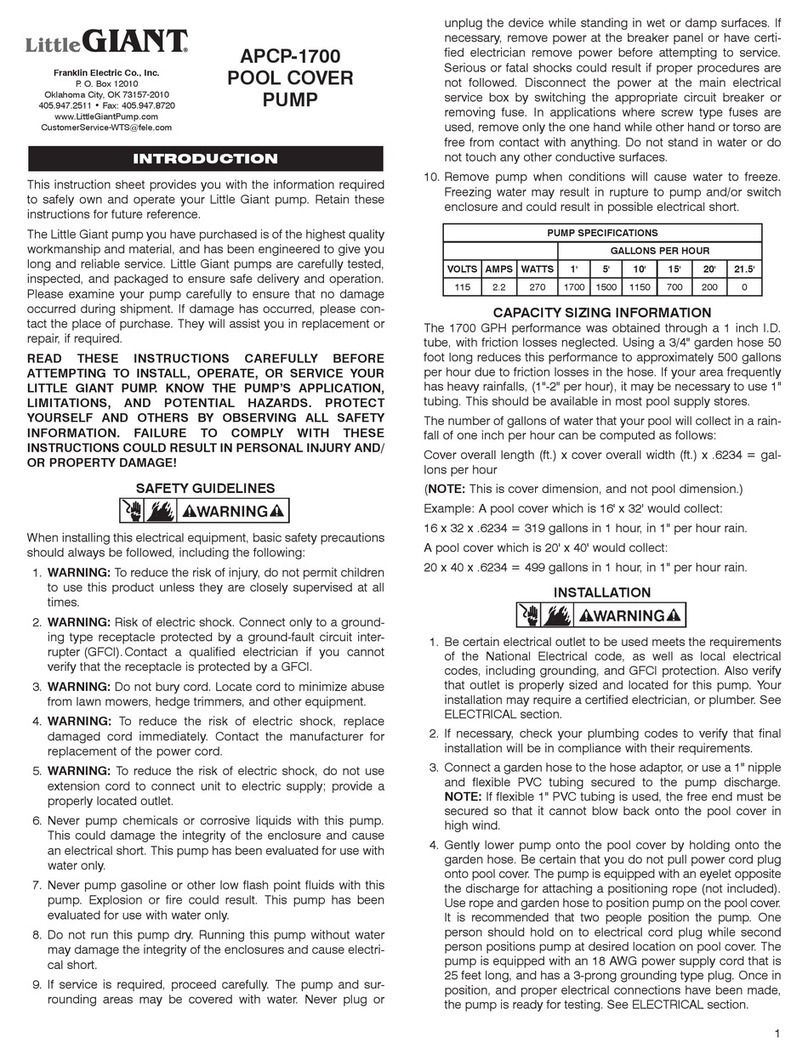
Little Giant
Little Giant APCP-1700 introduction

i-MO
i-MO CIRCOR D12DZ-250 Instruction manual and parts list
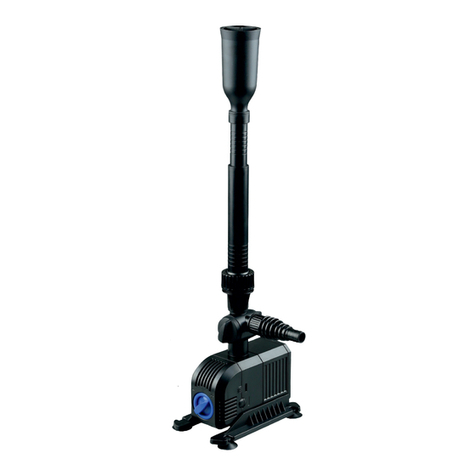
All Pond Solutions
All Pond Solutions FPP-600 manual

